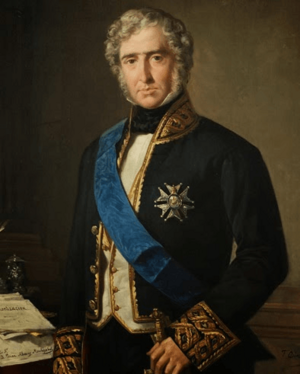Juan Álvarez Mendizábal facts for kids
Quick facts for kids
The Most Excellent
Juan Álvarez Mendizábal
|
|
|---|---|
 |
|
| Prime Minister of Spain | |
| In office 25 September 1835 – 15 May 1836 |
|
| Monarch | Isabella II |
| Preceded by | José María Queipo de Llano |
| Succeeded by | Francisco Javier de Istúriz |
| Personal details | |
| Born | 25 February 1790 Chiclana de la Frontera, Andalusia, Spain |
| Died | 3 November 1853 (aged 63) Madrid, Spain |
| Resting place | Pantheon of Illustrious Men |
| Political party | Partido Progresista |
Juan Álvarez Mendizábal (born Juan Álvarez Méndez; 25 February 1790 – 3 November 1853) was an important Spanish economist and politician. He served as the Prime Minister of Spain, which is like the head of government, from September 1835 to May 1836.
Contents
Early Life and Political Beginnings
Juan Álvarez Mendizábal was born in Chiclana de la Frontera, Spain. His father, Rafael Álvarez Montañés, was a cloth merchant. Juan learned a lot about banking and worked in a bank. He also helped with military finances during the Peninsular War, a big conflict in Spain.
In 1820, he was chosen to supply goods for the Spanish army. This army was sent by King Ferdinand VII to stop revolts in America. Mendizábal used this chance to help fund a military uprising led by Rafael del Riego. This uprising supported a more liberal government in Spain.
Exile and Return to Spain
When King Ferdinand VII took back all his power in 1823, many people who supported liberal ideas, including Mendizábal, had to leave Spain. Mendizábal went to the United Kingdom and started a successful trading business there.
He returned to Spain in 1835. The country was facing many problems. He was first made the Minister of the Treasury, which means he was in charge of the country's money.
Becoming Prime Minister
On 14 September 1835, Juan Álvarez Mendizábal became the Prime Minister of Spain. He also kept his role as Minister of the Treasury. This was a very difficult time for Spain. The country was spending a lot of money because of the First Carlist War.
Queen Regent Maria Christina, who was ruling for her young daughter Queen Isabella II, believed that a liberal prime minister like Mendizábal could help calm down the rebellions happening in the country.
Mendizábal's Big Plans
As Prime Minister, Mendizábal had several major goals:
- He wanted to end the Carlist War quickly.
- He aimed to get rid of the country's large public debt.
- He started a big change called the Desamortización Eclesiástica. This meant the government took control of properties owned by the Church and sold them.
The idea behind selling Church properties was to raise money for the government and to create a new group of landowners who would support the liberal government. However, these sales mostly benefited very wealthy people who could afford to buy large amounts of land.
Challenges and Later Roles
Mendizábal faced many challenges. He could not end the Carlist revolts as quickly as he hoped. Because of this, he had to resign as Prime Minister in 1836.
A few months later, there was another revolt. This led the Queen to agree to a more radical government. Mendizábal was again made the Minister of Finance. During this time, several important changes were made:
- The tithe, a tax paid to the Church, was stopped.
- Señoríos, which were old feudal rights, were abolished.
- People gained more freedom of the press.
- More Church properties were taken by the government.
In 1837, a more moderate government was elected. Mendizábal was again appointed Minister of Finance in 1843. However, he had to go into exile once more when politicians with different ideas came back to power.
He returned to Spain in 1847 and served in the Cortes, which is like the Spanish parliament, until he passed away in 1853.
See also
 In Spanish: Juan Álvarez Mendizábal para niños
In Spanish: Juan Álvarez Mendizábal para niños
| Political offices | ||
|---|---|---|
| Preceded by Miguel Ricardo de Álava |
Prime Minister of Spain 25 September 1835 – 15 May 1836 |
Succeeded by Francisco Javier de Istúriz |
| Minister of State Acting 4 October 1835 – 27 April 1836 |
Succeeded by The Count of Almodóvar |
|

